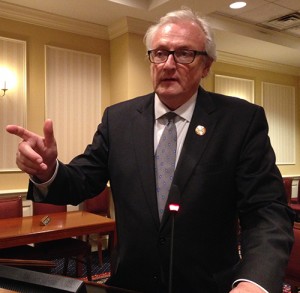
ANNAPOLIS — In this week’s legislative digest, the environmental study for a 3rd bridge spanning the Chesapeake Bay passes the Senate, the governor’s budget continues its move through the legislature and the number of tests given in Maryland public schools could be limited.
Senator Jim Mathias scored a significant political victory this week as Senate Bill 56, which requires the state fund an environmental impact study for a third bridge span across the Chesapeake Bay, passed through the Senate by a 40-4 vote.
While the decision doesn’t necessarily promise that there will be a third span someday, or even that the legislature is in favor of ever building such a span, it does signal that the Senate is overwhelmingly committed to considering a third bridge span as a viable option.
“This bipartisan action, including leadership of both parties, will strengthen our agriculture and poultry industry, promote tourism, provide for increased public safety, and ensure greater education opportunities for the students of Salisbury University, UMES, Washington College, Wor-Wic Community College, and Chesapeake College,” said Mathias, who represents District 38, including all of Somerset and Worcester counties and part of Wicomico County.
The bill, which was co-sponsored by Mathias and Senator John Astle (D-District 30), would also require the Maryland Transportation Authority to pay for the study.
Mathias and Astle tried to push this measure through in 2014, but the bill failed.
The bill still needs to pass through the House of Delegates, and ultimately, be signed by Governor Larry Hogan. The house hearing is scheduled for March 31.
“I remain dedicated and will continue to work with my Eastern Shore delegation, legislative leadership, colleagues in the House of Delegates, and Governor Hogan to pass and sign into law this vital bill to ensure a continued confidence and bright future for both the people of the Eastern Shore and the great state of Maryland,” said Mathias.
A study released last December by the Maryland Transportation Authority hinted that westbound traffic backups could stretch up to 14 miles during the summer months if the existing spans weren’t, at the very least, widened by 2040.
The MTA considered several options in that study concerning how to improve the existing spans, and the cost of those options were in the billions of dollars.
“Transportation is vital to everything we do on the Eastern Shore,” said Mathias in an interview with The Dispatch in October. “A third bridge span is vital for our continued growth and our economic development on the Eastern Shore.”
(CENTER/SUB)Budget Passes Houses, Senate
Governor Larry Hogan’s fiscal year 2017 operating budget for the state continues to move through the legislature as it passed the House of Delegates in Annapolis this week after being approved in the Senate last week.
The $42 billion budget includes no tax increases, more than $6 billion in support for public schools, a 6-percent spike in funding for the state’s public colleges and universities and a boost for the state’s tourism efforts.
In addition, there is $231 million allotted to transportation aid via Highway User Revenues and Capital Grants. Of that money, Worcester County will receive a little more than a million dollars and Wicomico County will receive roughly $1.3 million. Municipalities in those counties will receive $897,000 (Worcester) and $1.5 million (Wicomico).
Due to differences in the language in the house and senate versions of the bill, the process now moves to Conference Committee, where members of both the house and the senate will work out the differences in that aforementioned language.
Delegate Mary Beth Carozza (R-District 38C) said in a statement released on Wednesday, “While both the House and the Senate have made some changes to the governor’s initial proposal, this budget remains fiscally responsible while fully funding all our priorities.”
Standardized Tests Targeted
On Monday, the Maryland House of Delegates voted to restrict mandated standardized testing in the state’s public schools to 2% of instructional time, which roughly equates to about 20 hours per school year.
House Bill 141, which was spearheaded by Delegate Eric Luedtke (D-Montgomery County), was considered to be the bill that proverbially “clicked the most boxes” and deemed the “most comprehensive” of a bundle of bills aimed at limiting the number of tests mandated by federal, state, and local authorities.
Despite opposition from superintendents and school boards across the state, who opposed the bill’s often vague verbiage and its primary objective, subsequent bills aimed at limiting school testing have been moving through the house and the senate with general ease. Some (House Bill 412 and Senate Bill 533) are aimed at mandating that schools post information about standardized tests on the school website while another (House Bill 1233) is focused on contacting parents via email to when standardized tests will be given.
